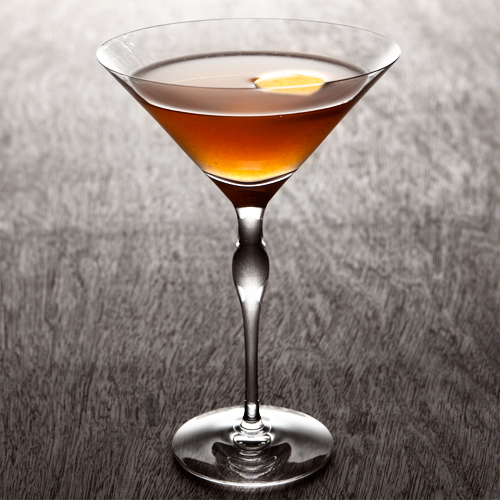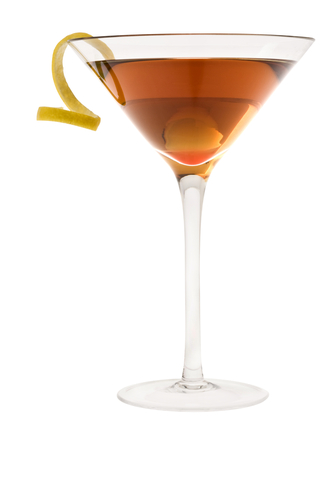Drink of the Week: The Tipperary
 If you’ve heard of the Irish town of Tipperary, and you’re not from Ireland or the UK, odds are it isn’t because of this cocktail but because of the song, “It’s a Long Way to Tipperary.” Gary Regan surmises that the drink is actually older than the song, but in my opinion the drink has aged at least as well as the somewhat treacly yet lovable English music hall ditty of World War I vintage.
If you’ve heard of the Irish town of Tipperary, and you’re not from Ireland or the UK, odds are it isn’t because of this cocktail but because of the song, “It’s a Long Way to Tipperary.” Gary Regan surmises that the drink is actually older than the song, but in my opinion the drink has aged at least as well as the somewhat treacly yet lovable English music hall ditty of World War I vintage.
With its combination of base spirit, sweet vermouth, and a small portion of the flavorful ringer that, in this case, is green Chartreuse — and its lack of bitters — it’s a fairly close relative of last week’s original Corpse Reviver. It’s also worth noting as being another of the very small but apparently growing group of cocktails to be made with Irish whiskey.
A few years ago, I found myself in an Irish pub in San Diego and I asked the bartender if he knew any Irish whiskey cocktails aside from Irish coffee. He had no idea. Well, now if you find yourself in an Irish bar, here’s another suggestion (assuming they’ve got some green chartreuse on hand).
The Tipperary
2 oz. Irish whiskey
3/4 oz. sweet vermouth
1/2 oz. green Chartreuse
Lemon twist (garnish)
Combine the ingredients, stir, and strain into a chilled cocktail glass. (A wine glass may also do for this one.) Add the lemon twist, sip, and salute the sweetest girl you know.
****
I can’t explain why, but I just couldn’t bring myself to try this one shaken, but I can’t stop you from doing so. As for brands, I tried both the classic Bushmills and the two less familiar brands that we’ve been playing with here in recent weeks, Concannon and Kilbeggan. While Bushmills is my actual favorite of the three — none of them are remotely bad — I was surprised to see that it was the darkhorse Concannon that held up most formidably among the onslaught of sweet vermouth and Chartreuse.
As for the vermouth, Carpano Antica, once again, beautifully dominated the drink, but Noilly Pratt, as usual, produced a nice harmony as well. If you feel tempted to try other proportions, feel free. There are numerous variations of this drink online that I wish I had time to play with. Gary Regan’s involves rinsing the glass with Chartreuse and then dumping the remains, which sounds a bit wasteful but might well be worth giving a try.
I could go on a bit more about this drink, but there’s really not that much to say. It’s been a sad and bittersweet week for those of us in the writing and media game as Roger Ebert’s death still hangs heavy in the air. Roger had stopped drinking before he became as world famous as he was destined to be and I’m not sure if it’s even right to mention him here. At the same time, it doesn’t seem right not to mention him here, and he did enjoy spending time in a good bar even after he stopped actually drinking.
It’s even odder to post a clip from a classic TV show rather than a classic movie — except, of course, that Roger was also part of a truly great TV show — but this is the best usage of the most famous song about Tipperary that I know. It’s also about the ending of something wonderful.
You can follow us on Twitter and Facebook for content updates. Also, sign up for our email list for weekly updates and check us out on Google+ as well.
Posted in: Food & Drink, Lifestyle, Vices
Tags: A Long Way to Tipperary, Bushmills Irish whiskey, Carpano Antica, cocktails, Concannon Irish Whiskey, Drink of the Week, Happy Hour, Irish whiskey, Kilbeggan Irish Whiskey, Mary Tyler Moore, Roger Ebert, sweet vermouth, The Corpse Reviver, The Mary Tyler Moore Show, The Tipperary, Tipperary

 As promised when I took on
As promised when I took on  Like most Americans, I’m not exactly a polyglot. Four years of junior high and high school Spanish have been of great assistance in helping me to order items at taco trucks; three quarters of college French allow me to chuckle knowingly to myself when “merde!” is translated as “damn!” in subtitles. So, I can’t properly pronounce the name of the Vieux Carre, but I can tell you it means “old square.” That square, as it turns out, is off of Bourbon Street in New Orleans, and this is another fine cocktail associated with America’s most intriguing cocktail capital.
Like most Americans, I’m not exactly a polyglot. Four years of junior high and high school Spanish have been of great assistance in helping me to order items at taco trucks; three quarters of college French allow me to chuckle knowingly to myself when “merde!” is translated as “damn!” in subtitles. So, I can’t properly pronounce the name of the Vieux Carre, but I can tell you it means “old square.” That square, as it turns out, is off of Bourbon Street in New Orleans, and this is another fine cocktail associated with America’s most intriguing cocktail capital. We’re continuing with the
We’re continuing with the 








